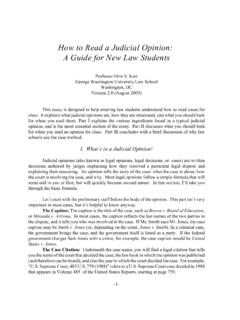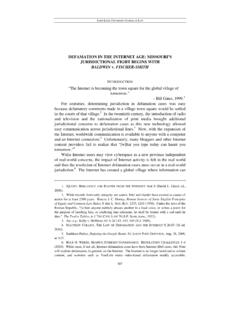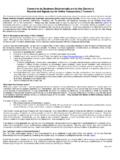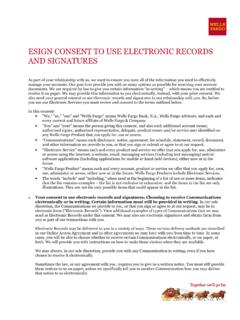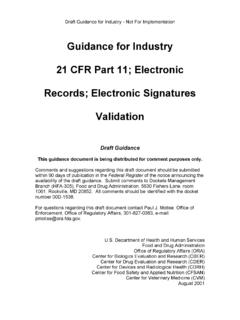Transcription of UNIFORM ELECTRONIC TRANSACTIONS ACT (1999)
1 UNIFORM ELECTRONIC . TRANSACTIONS ACT ( 1999 ). Drafted by the NATIONAL CONFERENCE OF COMMISSIONERS. ON UNIFORM STATE LAWS. and by it APPROVED AND RECOMMENDED FOR ENACTMENT. IN ALL THE STATES. at its ANNUAL CONFERENCE. MEETING IN ITS ONE-HUNDRED-AND-EIGHTH YEAR. IN DENVER, COLORADO. JULY 23 30, 1999 . WITH PREFATORY NOTE AND COMMENTS. Copyright 1999 . By NATIONAL CONFERENCE OF COMMISSIONERS. ON UNIFORM STATE LAWS. 1/20/00. UNIFORM ELECTRONIC TRANSACTIONS ACT ( 1999 ). The Committee that acted for the National Conference of Commissioners on UNIFORM State Laws in preparing the UNIFORM ELECTRONIC TRANSACTIONS Act ( 1999 ) was as follows: PATRICIA BRUMFIELD FRY, University of North Dakota, School of Law, Box 9003, Grand Forks, ND 58201, Chair STEPHEN Y. CHOW, 30th Floor, One Beacon St., Boston, MA 02108. KENNETH W. ELLIOTT, City Place Building, 22nd Floor, 204 N. Robinson Avenue, Oklahoma City, OK 73102.
2 HENRY DEEB GABRIEL, JR., Loyola University, School of Law, 526 Pine Street, New Orleans, LA 70118. BION M. GREGORY, Office of Legislative Counsel, State Capitol, Suite 3021, Sacramento, CA 95814-4996. JOSEPH P. MAZUREK, Office of the Attorney General, Box 201401, 215 N. Sanders, Helena, MT 59620. PAMELA MEADE SARGENT, Box 846, Abingdon, VA 24212. D. BENJAMIN BEARD, University of Idaho, College of Law, 6th and Rayburn, Moscow, ID 83844-2321, Reporter EX OFFICIO. GENE N. LEBRUN, Box 8250, 9th Floor, 909 St. Joseph Street, Rapid City, SD 57709, President HENRY M. KITTLESON, Box 32092, 92 Lake Wire Drive, Lakeland, FL 33802, Division Chair AMERICAN BAR ASSOCIATION ADVISORS. C. ROBERT BEATTIE, Plaza VII, 45 S. 7th Street, Suite 3400, Minneapolis, MN 55402-1609, Business Law Section AMELIA H. BOSS, Tmple University, School of Law, 1719 N. Broad Street, Philadelphia, PA 19122, Advisor THOMAS J.
3 SMEDINGHOFF, 130 E. Randolph Drive, Suite 3500, Chicago, IL 60601, Science and Technology Section EXECUTIVE DIRECTOR. FRED H. MILLER, University of Oklahoma, College of Law, 300 Timberdell Road, Norman, OK 73019, Executive Director WILLIAM J. PIERCE, 1505 Roxbury Road, Ann Arbor, MI 48104, Executive Director Emeritus Copies of this Act may be obtained from: NATIONAL CONFERENCE OF COMMISSIONERS. ON UNIFORM STATE LAWS. 211 E. Ontario Street, Suite 1300. Chicago, Illinois 60611. 312/915-0195. UNIFORM ELECTRONIC TRANSACTIONS ACT ( 1999 ). TABLE OF CONTENTS. SECTION 1. SHORT TITLE .. 4. SECTION 2. DEFINITIONS .. 4. SECTION 3. SCOPE .. 13. SECTION 4. PROSPECTIVE APPLICATION .. 20. SECTION 5. USE OF ELECTRONIC RECORDS AND ELECTRONIC SIGNATURES;. VARIATION BY AGREEMENT .. 20. SECTION 6. CONSTRUCTION AND APPLICATION .. 24. SECTION 7. LEGAL RECOGNITION OF ELECTRONIC RECORDS, ELECTRONIC .
4 SIGNATURES, AND ELECTRONIC CONTRACTS .. 26. SECTION 8. PROVISION OF INFORMATION IN WRITING; PRESENTATION OF RECORDS .. 28. SECTION 9. ATTRIBUTION AND EFFECT OF ELECTRONIC RECORD AND. ELECTRONIC SIGNATURE .. 31. SECTION 10. EFFECT OF CHANGE OR ERROR .. 33. SECTION 11. NOTARIZATION AND ACKNOWLEDGMENT .. 37. SECTION 12. RETENTION OF ELECTRONIC RECORDS; ORIGINALS .. 38. SECTION 13. ADMISSIBILITY IN EVIDENCE .. 42. SECTION 14. AUTOMATED TRANSACTION .. 42. SECTION 15. TIME AND PLACE OF SENDING AND RECEIPT .. 44. SECTION 16. TRANSFERABLE RECORDS .. 48. SECTION 17. CREATION AND RETENTION OF ELECTRONIC RECORDS AND. CONVERSION OF WRITTEN RECORDS BY GOVERNMENTAL. AGENCIES .. 56. SECTION 18. ACCEPTANCE AND DISTRIBUTION OF ELECTRONIC RECORDS BY. GOVERNMENTAL AGENCIES .. 56. SECTION 19. INTEROPERABILITY .. 58. SECTION 20. SEVERABILITY CLAUSE .. 61. SECTION 21. EFFECTIVE DATE .. 61. UNIFORM ELECTRONIC TRANSACTIONS ACT ( 1999 ).
5 PREFATORY NOTE. With the advent of ELECTRONIC means of communication and information transfer, business models and methods for doing business have evolved to take advantage of the speed, efficiencies, and cost benefits of ELECTRONIC technologies. These developments have occurred in the face of existing legal barriers to the legal efficacy of records and documents which exist solely in ELECTRONIC media. Whether the legal requirement that information or an agreement or contract must be contained or set forth in a pen and paper writing derives from a statute of frauds affecting the enforceability of an agreement, or from a record retention statute that calls for keeping the paper record of a transaction, such legal requirements raise real barriers to the effective use of ELECTRONIC media. One striking example of ELECTRONIC barriers involves so called check retention statutes in every State.
6 A study conducted by the Federal Reserve Bank of Boston identified more than 2500 different state laws which require the retention of canceled checks by the issuers of those checks. These requirements not only impose burdens on the issuers, but also effectively restrain the ability of banks handling the checks to automate the process. Although check truncation is validated under the UNIFORM Commercial Code, if the bank's customer must store the canceled paper check, the bank will not be able to deal with the item through ELECTRONIC transmission of the information. By establishing the equivalence of an ELECTRONIC record of the information, the UNIFORM ELECTRONIC TRANSACTIONS Act (UETA). removes these barriers without affecting the underlying legal rules and requirements. It is important to understand that the purpose of the UETA is to remove barriers to ELECTRONIC commerce by validating and effectuating ELECTRONIC records and signatures.
7 It is NOT a general contracting statute the substantive rules of contracts remain unaffected by UETA. Nor is it a digital signature statute. To the extent that a State has a Digital Signature Law, the UETA is designed to support and compliment that statute. A. Scope of the Act and Procedural Approach. The scope of this Act provides coverage which sets forth a clear framework for covered TRANSACTIONS , and also avoids unwarranted surprises for unsophisticated parties dealing in this relatively new media. The clarity and certainty of the scope of the Act have been obtained while still providing a solid legal framework that allows for the continued development of innovative technology to facilitate ELECTRONIC TRANSACTIONS . 1. With regard to the general scope of the Act, the Act's coverage is inherently limited by the definition of transaction. The Act does not apply to all writings and signatures, but only to ELECTRONIC records and signatures relating to a transaction, defined as those interactions between people relating to business, commercial and governmental affairs.
8 In general, there are few writing or signature requirements imposed by law on many of the standard TRANSACTIONS that had been considered for exclusion. A good example relates to trusts, where the general rule on creation of a trust imposes no formal writing requirement. Further, the writing requirements in other contexts derived from governmental filing issues. For example, real estate TRANSACTIONS were considered potentially troublesome because of the need to file a deed or other instrument for protection against third parties. Since the efficacy of a real estate purchase contract, or even a deed, between the parties is not affected by any sort of filing, the question was raised why these TRANSACTIONS should not be validated by this Act if done via an ELECTRONIC medium. No sound reason was found. Filing requirements fall within Sections 17-19 on governmental records. An exclusion of all real estate TRANSACTIONS would be particularly unwarranted in the event that a State chose to convert to an ELECTRONIC recording system, as many have for Article 9 financing statement filings under the UNIFORM Commercial Code.
9 The exclusion of specific Articles of the UNIFORM Commercial Code reflects the recognition that, particularly in the case of Articles 5, 8 and revised Article 9, ELECTRONIC TRANSACTIONS were addressed in the specific contexts of those revision processes. In the context of Articles 2 and 2A the UETA provides the vehicle for assuring that such TRANSACTIONS may be accomplished and effected via an ELECTRONIC medium. At such time as Articles 2 and 2A are revised the extent of coverage in those Articles/Acts may make application of this Act as a gap-filling law desirable. Similar considerations apply to the recently promulgated UNIFORM Computer Information TRANSACTIONS Act ( UCITA ). The need for certainty as to the scope and applicability of this Act is critical, and makes any sort of a broad, general exception based on notions of inconsistency with existing writing and signature requirements unwise at best.
10 The uncertainty inherent in leaving the applicability of the Act to judicial construction of this Act with other laws is unacceptable if ELECTRONIC TRANSACTIONS are to be facilitated. Finally, recognition that the paradigm for the Act involves two willing parties conducting a transaction electronically, makes it necessary to expressly provide that some form of acquiescence or intent on the part of a person to conduct TRANSACTIONS electronically is necessary before the Act can be invoked. Accordingly, Section 5 specifically provides that the Act only applies between parties that have agreed to conduct TRANSACTIONS electronically. In this context, the construction of the term agreement must be broad in order to assure that the Act applies whenever 2. the circumstances show the parties intention to transact electronically, regardless of whether the intent rises to the level of a formal agreement.


